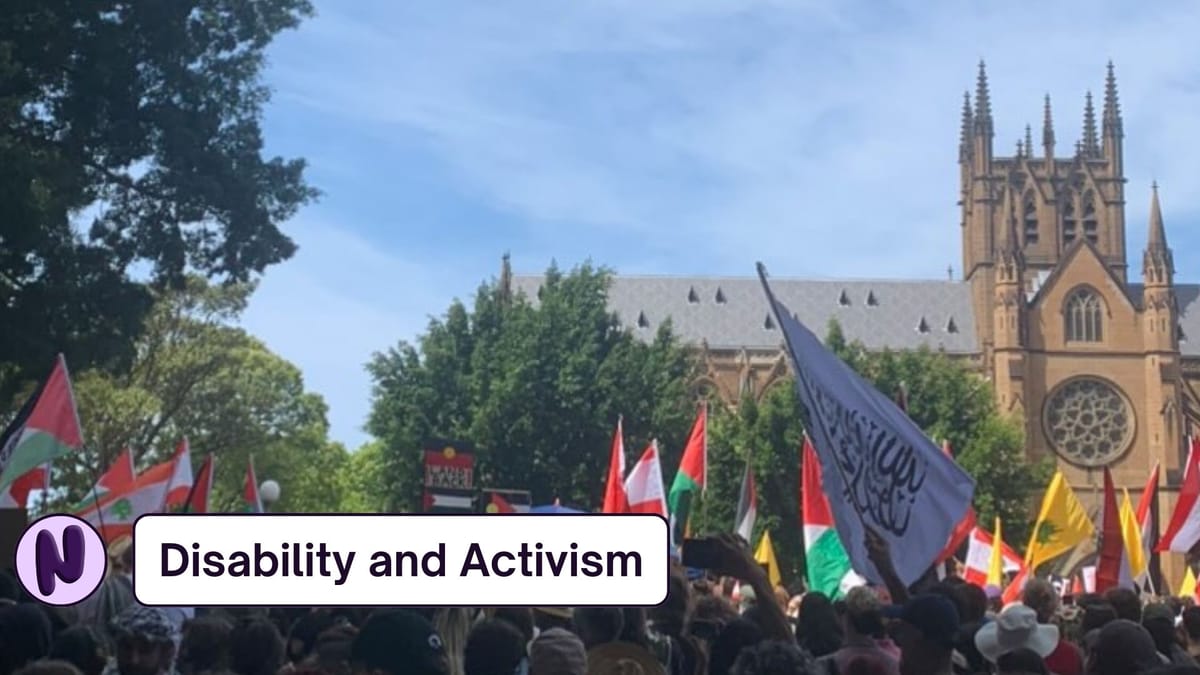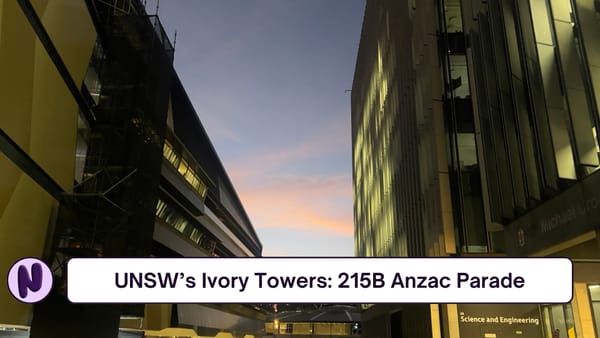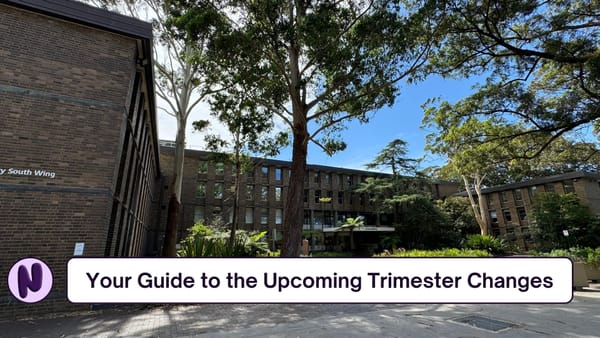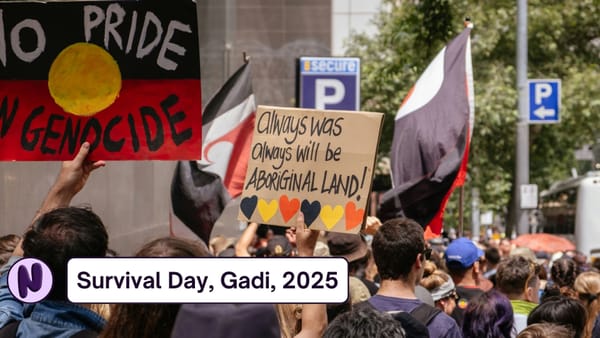Disability and Activism
SRC Students with Disabilities Officer Conroy explores the issues around accessibility in activist movements.

Over the past eighteen months, the Federal Labor Government has made several attacks toward the Disabled community. This has included major slashes to funding for the National Disability Insurance Scheme (NDIS), a scheme which provides disabled people with funding to access items and services to allow them to achieve autonomy and independence. These cuts will essentially condemn many to life without liberty or even death. These cuts have been made due to “rising costs.” Simultaneously, the government has found room in its budget for multi-billion dollar nuclear warships with power far beyond our defensive needs, and has also allowed one third of corporations, including major coal and gas companies, to pay no tax. The government has also ignored many of the recommendations laid out by the Disability Royal Commission report, which aimed to support independence of and fight abuse and violence against disabled people in this country. The combination of these attacks and many more has made me and many other disabled people feel like second-class citizens unworthy of being given liberty.
Activism takes place in many forms, involving things such as mutual aid, community building, and lobbying political representatives and the media. Some of these tools were used to bring attention to the cuts and support struggling disabled people afterwards. I couldn’t help but notice not a single action was organised to fight back or bring attention to attacks on disabled people. Even in other instances where attacks on disabled people could easily be connected to ongoing activist campaigns through intersectionality, such as how the housing crisis has made accessible housing harder to find, or how disabled people are disproportionately affected by the ongoing genocide in Gaza, these links were never drawn.
I went on a hunt to find a disability activist organisation to try to get some initiative going to fight back against these attacks. I thought it would be a given that at least one organisation existed since so many other minority groups had activist organisations to amplify their rights such as Black Peoples Union for First Nations Australians, Pride in Protest, for Queer People, and Refugee Action Coalition for Refugees. For disabled people, there was not one to be found.
In furthering my quest to try to bring some initiative to starting disability activism, I put myself forward to run for Students with Disability Officer at UNSW to try to stir up discussion about disability issues and possibly win the position, with the hopes of steering a dormant Disabilities Collective to a budding space of activism. However, upon being elected, I realised that disabled activism at the University was not just dormant but has not been present for so many years it would be fair to call it dead.
At first, the absence of any real disability activism organisations or disability activism at UNSW shocked me, but upon more reflection, I’ve realised just how many structural barriers there are stopping disabled people from engaging in activist spaces or stepping up to be an organiser.
1. Avoiding endless petitions and unsolicited interactions
Upon my journey to discover why disability activism in Sydney is significantly less prominent than other areas of activism, I remembered that the initial significant barrier to actively engaging in activist spaces was the behaviour of other activists at rallies.
Many organisations involved in activist spaces hold a theory of change that involves their representative organisation building a mass movement of party members to overthrow the political establishment. Understandably, those organisations invest particular time at rallies in an attempt to recruit people sympathetic to their cause, either by encouraging them to come to a meeting or reading their publication.
Rallies tend to be the biggest recruitment spaces for these organisations as attendees are far more likely to hold their views. Therefore, those organisation’s members are trained to engage and recruit new members. Especially because multiple organisations attend these rallies and compete for new members against each other, the style of recruitment is often highly militant and competitive.
What ends up happening is that recruiters will aggressively persist in conversation with attendees, regardless of whether they show signs of discomfort, anxiety, or disinterest. For many neurodivergent people, this can set off anxiety attacks or feelings of discomfort and may make them feel unsafe to come back and re-engage in activist spaces.
These recruiters may take up significant space around rallies so they can maximise the number of attendees they approach, making navigating a protest particularly challenging and also making them an unsafe space for people with mobility or sensory issues.
2. Rising Anti-Protest Laws
A second barrier I pondered upon recalling my early stages of activism, but also particularly more recently, was how authorities, including the NSW Government and Universities, deliberately make protests feel unsafe to discourage attendance, and such unsafety may be particularly felt by disabled people.
It is no secret that governments and authorities do not like protests. It may disrupt their activities or bring attention to the wrongdoings they wish to hide. Because of this, these organisations have deliberately constructed regulations around activism in a way that makes engagement as uncomfortable for attendees as possible.
This looks like sending an inordinate amount of police officers to surround a small marching protest, confining attendees to a restricted area, which may be inaccessible for some, or cause accessibility problems for passersby, like UNSW Security reportedly did during a rally in solidarity with the Bangladeshi Striking Students last year. This may make people feel uncomfortable or unsafe, given the history of police abuse towards minorities, or potentially make people fear they are committing a crime, despite the fact they are merely exercising the inherent right to congregate and exercise freedom of speech.
Particularly, recently growing rules and regulations about protests, including increasingly difficult requirements to gain permits to protest and increasing restrictions at Universities on the types of protests that can be conducted and what activities can happen, have made protests an increasingly difficult place to navigate, decreasing engagement.
3. Lack of accessibility considerations by rally organisers
Rallies are places that contain many unknowns. How loud will it be? What path will the route take? When will the event finish?
These are questions that are vital for disabled people to know before attending rallies, but often forgotten.
There is seldom information provided by rally organisers as to the routes the rally will take. Additionally, information such as whether it’s accessible for wheelchair users, whether there is accessible parking nearby, or whether there are accessible public transport exits. This may require disabled people to take the risk and assume the route will be accessible, potentially to their detriment, or let that be a barrier stopping them from attending.
There is also rarely information as to what style of protests will be occurring. There has been a rise in recent times of activism focused on being visible by being loud rather than placing yourself in a strategically visible spot. These forms of actions put disabled people at risk of sensory overload if they are unable to prepare in advance and bring things that help them in these situations, like earmuffs.
4. The path to becoming an organiser
Whilst the points I discussed before are generally relevant in explaining why disabled people may have difficulties engaging in activism, there are disabled activists everywhere, including myself, and whilst we support other organisers’ rallies, events and aid initiatives in solidarity, there have been very few disabled people who have made that step up to organising for issues relevant to disabled people.
Organising rallies and other activist activities is an incredibly draining activity. You need to fill in paperwork to organise the march and gather materials like speakers, banners, and microphones. You need to contact other activists to spread the event around. You need to find ways to print flyers and posters and distribute them. Certain disabilities may make these tasks more physically and emotionally draining, and particularly as there is currently no group organising around disability issues, people cannot pool their collective strengths together.
The takeaway
If the Sydney activist scene is to improve disability engagement in direct forms of action, there is serious work to do in making activist spaces a safer place for disabilities. Of course, disabled people could continue to organise and participate in other avenues of activism, but the skills gained through organising rallies and direct actions are very transferable and can bring effectiveness to fighting for our liberation. Hopefully, and ideally, filtering more disabled people into activist spaces can create an organic grassroots disability activist organisation.



